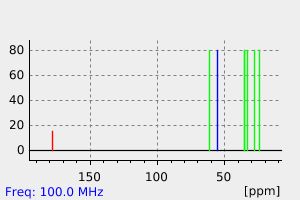1-oxide-β-lipoic acid
中文名称
——
中文别名
——
英文名称
1-oxide-β-lipoic acid
英文别名
5-(1-Oxodithiolan-3-yl)pentanoic acid
CAS
——
化学式
C8H14O3S2
mdl
——
分子量
222.329
InChiKey
HRIQWEOKIFSCBV-UHFFFAOYSA-N
BEILSTEIN
——
EINECS
——
-
物化性质
-
计算性质
-
ADMET
-
安全信息
-
SDS
-
制备方法与用途
-
上下游信息
-
文献信息
-
表征谱图
-
同类化合物
-
相关功能分类
-
相关结构分类
计算性质
-
辛醇/水分配系数(LogP):0.6
-
重原子数:13
-
可旋转键数:5
-
环数:1.0
-
sp3杂化的碳原子比例:0.88
-
拓扑面积:98.9
-
氢给体数:1
-
氢受体数:5
上下游信息
反应信息
-
作为产物:参考文献:名称:一种硫辛酸氧化杂质的制备方法摘要:本发明涉及一种化学制备硫辛酸氧化杂质的方法,属于医药合成技术领域。所述的硫辛酸氧化杂质其结构式如下:所述的硫辛酸氧化杂质化合物的制备方法包括以下步骤:首先用硫辛酸在有机溶剂中与醇类在缩合剂的作用下成酯;然后将硫辛酸的醇酯化合物溶于有机溶剂中,在氧化剂的作用下生成四个硫辛酸醇酯的氧化产物,根据化合物的Rf值的差异进行柱层析纯化,得到四个中间体化合物;最后将四个中间体化合物分别在碱性水溶液中水解得到四个硫辛酸氧化杂质化合物I、II、III、IV。本发明提供的硫辛酸氧化杂质化合物的合成制备方法能获得单个氧化杂质,且简单易行,易于实施。公开号:CN106866620B
文献信息
-
Oxidation of Disulfides to Thiolsulfinates with Hydrogen Peroxide and a Cyclic Seleninate Ester Catalyst作者:Nicole McNeil、Ciara McDonnell、Miranda Hambrook、Thomas BackDOI:10.3390/molecules200610748日期:——of regioisomers. Lipoic acid and N,N′-dibenzoylcystine dimethyl ester were oxidized readily under similar conditions. Although isolated yields of the product thiolsulfinates were generally modest, these experiments demonstrate that the method nevertheless has preparative value because of its mild conditions. The results also confirm the possibility that cyclic seleninate esters could catalyze the further环状硒酸酯用作抗氧化剂硒酶谷胱甘肽过氧化物酶的模拟物。它们用硫醇催化有害过氧化物的还原,硫醇在此过程中转化为二硫化物。研究了在这些条件下硒酸酯还可以催化二硫化物进一步氧化为硫代亚磺酸盐和其他过度氧化产物的可能性。这对硒酸酯的潜在医学应用产生了影响,因为它可能催化含二硫化物的旁观肽和蛋白质的不需要的氧化。多种芳基和烷基二硫化物在催化苯并-1,2-氧杂硒代硒氧化物存在下用过氧化氢进行轻松氧化,得到相应的硫代亚磺酸盐作为主要产物。不对称的二硫化物通常提供区域异构体的混合物。硫辛酸和 N,N'-二苯甲酰胱氨酸二甲酯在类似条件下很容易被氧化。尽管产物硫代亚磺酸盐的分离产率一般不大,但这些实验表明该方法仍然具有制备价值,因为它的条件温和。结果还证实了环状硒酸酯可以催化体内二硫化物进一步不希望的氧化的可能性。
-
Cyclic Thiosulfinates and Cyclic Disulfides Selectively Cross-Link Thiols While Avoiding Modification of Lone Thiols作者:Daniel P. Donnelly、Matthew G. Dowgiallo、Joseph P. Salisbury、Krishna C. Aluri、Suhasini Iyengar、Meenal Chaudhari、Merlit Mathew、Isabella Miele、Jared R. Auclair、Steven A. Lopez、Roman Manetsch、Jeffrey N. AgarDOI:10.1021/jacs.8b01136日期:2018.6.20thiol-selective cross-linkers, for example, modify all accessible thiols, but only form cross-links between a subset. The resulting terminal "dead-end" modifications of lone thiols are toxic, confound cross-linking-based studies of macromolecular structure, and are an undesired, and currently unavoidable, byproduct in polymer synthesis. Using the thiol pair of Cu/Zn-superoxide dismutase (SOD1), we demonstrated这项工作解决了对可以选择性形成交联的化学工具的需求。例如,现代硫醇选择性交联剂修饰所有可访问的硫醇,但仅在子集之间形成交联。由此产生的孤立硫醇的末端“死端”修饰是有毒的、基于交联的大分子结构研究,并且是聚合物合成中不希望的、目前不可避免的副产品。使用铜/锌超氧化物歧化酶 (SOD1) 的硫醇对,我们证明了环状二硫化物,包括药物/营养补充剂硫辛酸,有效地交联了硫醇对,但避免了死端修饰。硫醇盐导向的对环状二硫化物的亲核攻击导致硫醇-二硫化物交换和环断裂。所得的二硫化物连接的末端硫醇盐部分要么引导反向反应,释放环状二硫化物,要么参与氧化二硫化物(交联)的形成。我们假设并通过密度泛函理论 (DFT) 计算证实,环状二硫化物的单 S-氧代衍生物在环裂解时形成末端次磺酸,避免了之前的限速步骤,硫醇氧化,并加速了新的速率-确定步骤,环裂解。我们的计算表明,加速环裂解的起源是硫醇盐-二硫化物交换转变中改进
-
[EN] HETEROCYCLIC-DITHIOL CLICK CHEMISTRY<br/>[FR] CHIMIE CLICK DE DITHIOL HÉTÉROCYCLIQUE
-
Rhenium-Catalyzed Oxidation of Thiols and Disulfides with Sulfoxides作者:Jeffrey B. Arterburn、Marc C. Perry、Sherry L. Nelson、Benjamin R. Dible、Mylena S. HolguinDOI:10.1021/ja972013r日期:1997.10.1
-
HETEROCYCLIC-DITHIOL CLICK CHEMISTRY申请人:NORTHEASTERN UNIVERSITY公开号:US20210161789A1公开(公告)日:2021-06-03Disclosed are polymers, methods of making polymers, and compositions, focused on cross-linking heterocycles comprising a moiety of Formula I with thiols and thiolates.
表征谱图
-
氢谱1HNMR
-
质谱MS
-
碳谱13CNMR
-
红外IR
-
拉曼Raman
-
峰位数据
-
峰位匹配
-
表征信息
同类化合物
螺[二环[2.2.1]庚烷-2,2'-[1,3]二噁戊环]-5-乙醇,(1S,4R,5R)-
芦笋酸
硫辛酸钠
硫辛酸氨基丁三醇盐
硫辛酸杂质D
硫辛酸杂质9
硫辛酸乙酯
硫辛酸-二聚乙二醇-马来酰亚胺
硫辛酰氨基-PEG12-羧酸
甲基沙蚕毒素
沙蚕毒素
氨基乙醛乙烷二硫代缩醛
左旋硫辛酸
呋喃-2-甲醛乙烷-1,2-二基二硫代缩醛
二乙基硫辛酰胺
三硫代碳酸乙烯酯
rac-α-硫辛酸-d5
R-(alpha)-硫辛酸氨基丁三醇盐
R-(+)-硫辛酸
N-(1,3-二噻戊环-2-亚基氨基)乙酰胺
N-(1,3-二噻戊环-2-亚基氨基)-2-氧代丙酰胺
L-赖氨酸单-1,2-二噻戊环-3-戊酸盐
DL-α-硫辛酸-NHS
5-[(3R)-二噻戊环-3-基]戊酸;2-羟基丙酸
4-甲基二噻戊环-3-酮
4-甲基-1,3-二硫醇-2-酮
4-甲基-1,3-二噻戊环-2-亚胺盐酸盐
4-甲基-1,2-噻吩-4-羧酸
4-甲基-1,2-二噻吩-4-羧胺
4-噻唑烷酮,3-(二甲氨基)-2-亚硫酰基-,(Z)-
4-乙基-1,3-二噻戊环-2-硫酮
4-[[5-(1,2-二噻戊环-3-基)-1-氧代戊基]氨基]丁酸
4-[(苯基硫基)甲基]苯甲酸
4,5-二甲基-2-[2-(甲硫基)乙基]-1,3-二噻戊环
3-环丁烯砜-D6
2-甲基-1,3-二硫戊环
2-异丙基-4-甲基-1,3-二噻戊环
2-己基-1,3-二噻戊环
2-亚甲基-1,3-二硫杂环戊烷
2-(氯甲基)-1,3-二噻戊环
2-(三氯甲基)-1,3-二噻戊环
2-(2-噻吩基)-1,3-二噻戊环
2-(2,4-环戊二烯-1-亚基)-1,3-二硫戊环
2-(1,3-二噻戊环-2-基)-1,3-二噻戊环
2-(1,2-二硫烷-3-基)乙酸
2,4-二氯-6,7-二硫杂双环[3.2.1]辛烷
2,3-二硫杂螺[4.4]壬烷
2,3,7,8-四硫杂螺[4.4]壬烷
2,2'-[1,2-乙烷二基二(硫代)]二[2-(三氟甲基)-1,3-二噻戊环]
1,‐2-二硫戊基-4-醇







